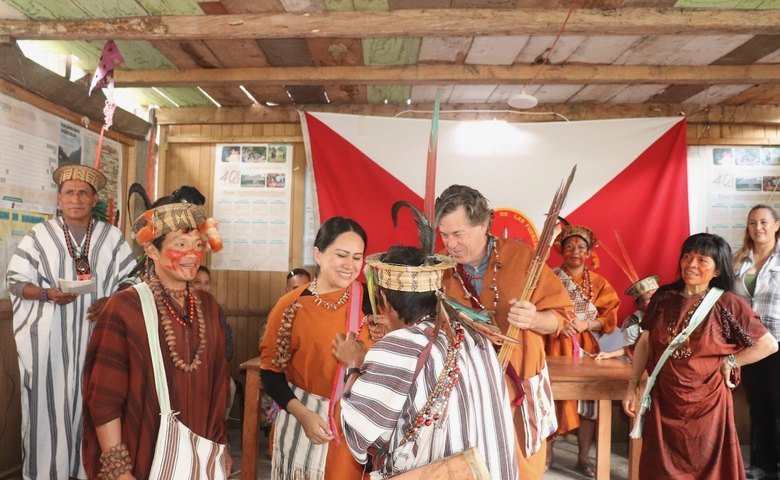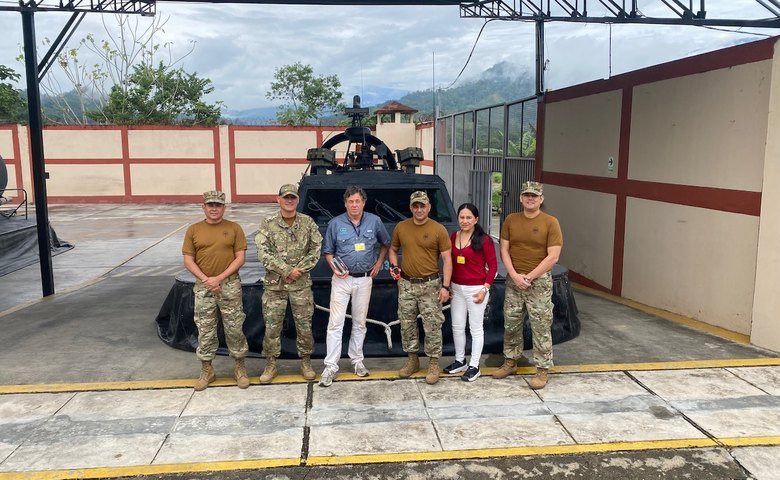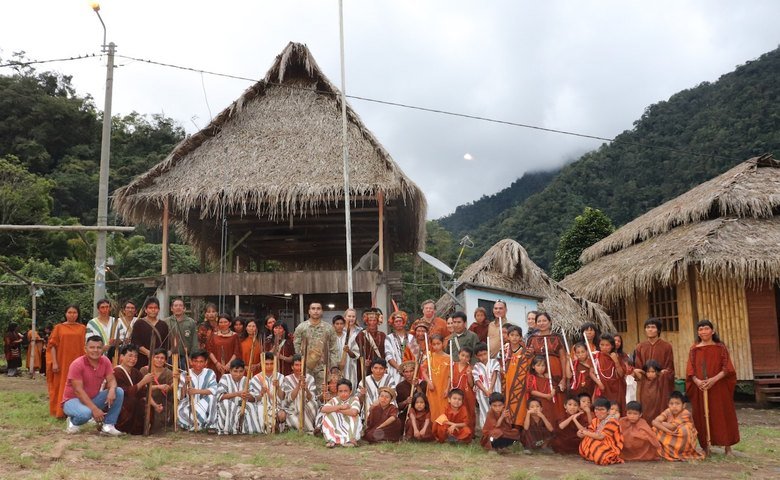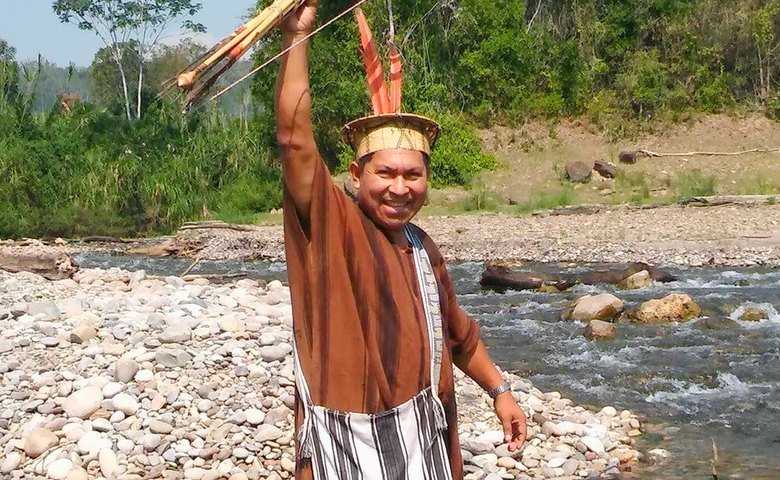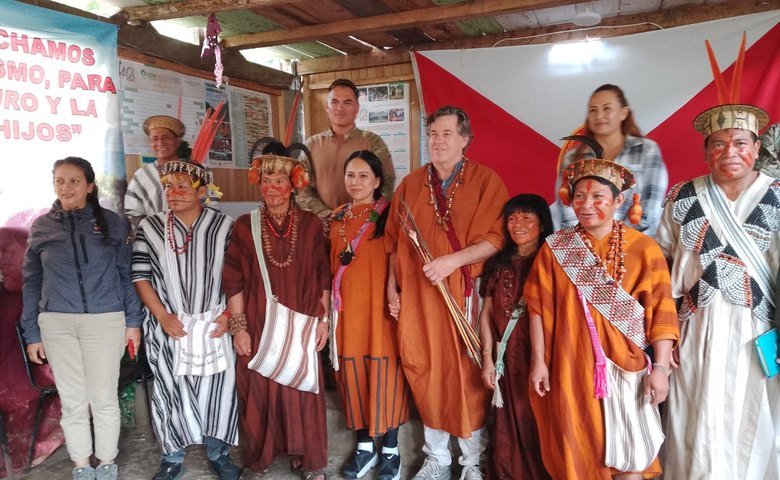GC Mission - Stopping Deforestation In Peru’s National Parks
In May 2023, Global Conservation is invited by the Government of Peru to assist in deploying Global Park Defense in two critical areas facing deforestation: Otishi National Park and Asháninka Communal Reserve, covering over half a million hectares in the Amazon region of Peru.
SERNANP, Peru's National Parks Authority, has made astounding progress to reduce deforestation to under 2,800 hectares in 2022 in 'Core Areas' nationwide, a stunning achievement. The challenges for Peru's National Parks and Reserves lie largely in the large communal and multi-use zones surrounding the national parks.
In Otishi National Park, we are building the first-ever cooperation for Park and Communal Reserve Protection between the Asháninka People in the Asháninka Communal Reserve of Peru, SERNANP, and the Joint Command of the Peruvian military to assist local indigenous communities to better protect their indigenous territories against illegal logging, coca cultivation, and invasive settlements.
Otishi National Park protects the Cordillera de Vilcabamba and its beautiful river basins of the Ene, Tambo, and Urubamba rivers. 99% of the surface of Otishi National Park is still in a natural state due to its steep mountain geology and impenetrable forests, but surrounding areas are largely cut or fragmented with heavy clearing for agriculture.
The Asháninka Communal Reserve is recognized as a protected area category in Peru, where its indigenous and other communities should benefit and share responsibility for protection and management.
Jeff Morgan, Executive Director, and Margoth Quispy, Director of South America for Global Conservation, opened a new chapter in Community Protection for Otishi National Park and Asháninka Communal Reserve.
The Asháninka are estimated to number between 25,000 and 45,000 people who live in remote valleys and are mostly dependent on subsistence agriculture. They use the slash-and-burn method to clear lands and plant yucca roots, sweet potatoes, corn, bananas, rice, coffee, cacao, and sugar cane using biodiversity-friendly techniques. Hunting, fishing, and foraging for fruits and vegetables in the jungle are core to their livelihoods. They use bows and arrows or spears as their traditional weapons of choice.
For over a century, there has been encroachment onto Asháninka land by loggers, Maoist guerrillas, drug traffickers, colonists from other regions, and oil companies.
Deforestation just outside Otishi National Park for coca cultivation has devastated 80% of the rainforests.
Integrated Protection for Indigenous Territories
Satellite and Aerial Monitoring
Park-wide Communications
Rapid Response Teams
Border Demarcation
Biodiversity Recovery
The primary goal of Community Protection is to work with SERNANP and Global Conservation to deploy Global Park Defense in their territories for forest monitoring and initiate rapid response efforts to deforestation from coca cultivation and illegal logging while in close coordination with law enforcement and the military when needed.
Another vital goal is to increase on-the-ground patrolling in the entire area from Patria / Tono and Boca Manu / Linona in order to increase Community Protection from nearly ground zero to over 10,000 kilometers of patrolling a year in the next two years.
In the past ten years, previously untouched areas have been assaulted by a combination of coca cultivation, agricultural expansion, cattle ranching, and now urban expansion.
Up until the more recent introduction of a genetically altered coca plant that thrives in the Amazon's lowlands, the coca plant used to make cocaine was only grown in isolated locations at high elevations. This has caused a catastrophe clearing hundreds of thousands of hectares of intact tropical Amazon forests. Now, even the farthest reaches of the Amazon in National Parks and Indigenous Reserves are facing land clearing for coca cultivation, and local communities and park rangers are in serious danger.
Asháninka Protection Force for Otishi National Park and the Asháninka Communal Reserve combined with National Park Rangers, law enforcement, and military support.
Deploying Global Park Defense (GPD) in partnership with the Asháninka Indigenous Communities, SERNAP, the Peruvian Air Force, Naval Marines, and law enforcement will deliver the critical expansion of protection across over 400 kilometers and 400,000 hectares focused on two primary areas with 10 indigenous communities.
This integrated model, which Global Conservation Peru created over the course of five years in Sierra del Divisor National Park, is currently being scaled to include the combined 5 million hectares of Otishi and Manu National Parks and their Indigenous Territories.
Never before have Peru's National Parks worked so closely with all key governmental organizations and their combined resources in partnership with local communities to stop the environmental damage of its National Parks. Due to Peru's long history of establishing National Parks and Indigenous Territories, we now need to work harder together in order to protect them.
Mapping Deforestation for Rapid Response
Using satellites to identify deforestation in the National Park and surrounding Communal Reserves, which are supported by high-resolution aerial overflights to clearly identify specific areas for targeting combined interdictions, enables the Park Authority to prioritize scarce resources by deciding where and when to patrol, when to secure backup from law enforcement, and where to better locate ranger stations to stop deforestation and illegal activities.
By responding rapidly to threats, illegal settlements, and coca growers are discouraged from entering and destroying National Park forests and associated killing of wildlife to feed their crews. By increasing the fear of interdiction and arrest, we greatly discourage illegal activities within the National Park and via critical access routes.
Due to rapidly changing weather and extensive cloud cover in the Amazon, getting clear photography and sensor information can be quite tricky. In order to have concise information for on-the-ground patrols, we use a combination of four critical layers:
Satellite
Airplane
Drone
Intelligence
Global Conservation will support the development of a 30-person Manu Community Protection Force deploying Global Park Defense over the next 2 years with the primary goals:
Equip and Training 30 Community Ecoguards from 10 Communities
Hire an Enforcement Manager living in the Region
Logistics for 10,000+ kilometers of Patrolling per year
SMART System Deployment – Protection and Biodiversity
Coordinate Arrests and Relocations with Park Authorities
Satellite and Aerial Forest Monitoring
Coordination with SERNANP and Law Enforcement
Deploying Global Park Defense
Focus on five high-threat areas using satellites and aerial monitoring.
Intensive patrolling by foot, truck, and boat in these areas.
Coordinate with law enforcement for arrests and removal of illegal presences.
The Endless Destruction of Coca
Although few indigenous or Peruvian peoples use cocaine, coca planting is devastating Peru's Amazon. Coca is a successful economic crop for the area due to its high value, lengthy shelf life, and ease of transportation. Coca, along with corn and yuca, is now the main crop for the majority of people.
In order to eliminate coca cultivation within the National Park, major police and military operations are often needed to search and destroy fields that are deep within the jungle. One recent, massive operation required over 200 police and military personnel focused on removing the cocaine cartels operating in a national reserve, which destroyed over 100,000 hectares of intact primary forest.
Now, by building multiple new ranger stations staffed with many police in key access areas, Ashaninka Reserve is holding back the regrowth of this cancerous activity in pristine, intact tropical forests.
Clandestine landing strips in the rainforest can be seen from the air. Within walking distance are clusters of deforestation—coca cultivation between one and five hectares, turning intact forests into fragmented, degraded forests. The environmental impact of narcotrafficking, or narco-deforestation, has been significant, not only in Peru but throughout South America and Central America too, where it is estimated to be responsible for a quarter of all forest loss in Guatemala, Honduras, and Nicaragua.
In the Ucayali, where Global Conservation works to protect Sierra del Divisor National Park, analysis of data from Peru’s GERFFS agency shows that 4% of deforestation takes place in natural parks and conservation areas, and over half of narco-deforestation takes place on land given over to large companies as logging concessions.
Assassinations of Police and Environmental Leaders
The NGO National Coordinator of Human Rights reported in August 2022 that 20 indigenous leaders and defenders of the Amazon have been murdered between 2020 and 2022 by criminals linked to drug trafficking, illegal mining, illegal logging, and the trafficking of lands.
Last year, seven National Police officers were gunned down outside Otishi National Park, and recently, 16 cartel operatives were arrested. Just last month, an Asháninka Community President was killed in the same area, likely for resisting cartel invasions in his Indigenous Territories. Assassinations of environmental leaders in Peru over the past ten years have claimed over 300 victims.
Asháninka Community leader Santiago Contoricón was killed in his home by cartel gunmen in April 2023. Authorities report that the murder may have been in retaliation for recent drug seizures made in the region, which is a hotbed for cocaine production and trafficking. Contoricón was well known for his fight against the use of Asháninka territory for coca cultivation and drug trafficking.
The Asháninka are one of South America’s largest indigenous tribes and the ethnic group to which Contoricón belonged. The Indigenous leader was allegedly killed by hitmen who fled on a motorcycle. Contoricón was found dead in his house, located in the community of Puerto Ocopa, in Junn’s jungle region.
Contoricón’s death is clearly not an isolated case. According to the NGO Global Witness, from 2002 to date, 60 Indigenous leaders and environmental activists have been murdered in the country.
A statement from the Central Asháninka de Ro Tambo (CART), an indigenous organization that represents 35 native communities, criticized authorities, saying, "We are alone facing drug trafficking and terrorism." CART reported that Contoricón collaborated closely with the police and the army. "In recent years, we have seized several tons of cocaine and handed it over to the anti-drug police. That is the reason for this murder," the statement read. "Governments have abandoned us, and, as a consequence, criminal organizations linked to illegal economies are murdering our leaders with impunity," read the message.
Global Conservation will be there to support the Ashaninka People and their fight to protect their land, traditions, and families.
Global Conservation in Peru
Global Conservation is focused on the protection of three National Parks and two Indigenous Territories in the Amazon:
Sierra del Divisor National Park and the Nueva Sapasoa Indigenous Community
Otishi National Park and the Asháninka Communal Reserve
Manu National Park and the Machiguenga Communities
As well, Global Conservation is deploying Marine Protection in Paracas for the Nazca Marine Protected Area, the largest in Peru. See here for more information on Global Conservation’s work in Marine Protection.


